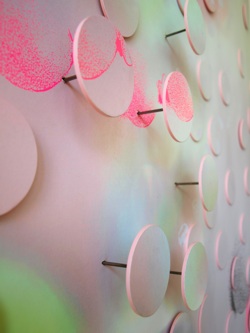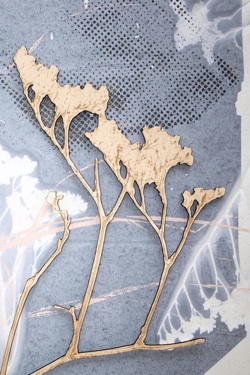A magazine where the digital world meets the real world.
On the web
- Home
- Browse by date
- Browse by topic
- Enter the maze
- Follow our blog
- Follow us on Twitter
- Resources for teachers
- Subscribe
In print
What is cs4fn?
- About us
- Contact us
- Partners
- Privacy and cookies
- Copyright and contributions
- Links to other fun sites
- Complete our questionnaire, give us feedback
Search:
A different kind of airbrushing

If you’re in a room and the walls look like they’re moving, you might think it’s time for a trip to the hospital. If you’re in a room with Chloe Albert’s animated wallpaper, though, it means you’re less likely to need the hospital in the future. That’s because she’s designed some ingenious animated wallpaper with built-in air filters, which respond to pollution in the air around you and help clean it up.
Her project is called Filter the Filth, and she made it as a master’s student in Textile Futures at Central Saint Martins College of Art and Design in London. It starts with two wallpaper patterns – one with clouds of pink, green and blue, and another that mixes big slabs of grey with gold tree branches. The colours are nice, but they’re not what sets Chloe’s wallpaper apart. Her design calls for sensors that take a reading of the pollution inside a room. When the readings get above a certain level, motorised filters poke out of the wallpaper pattern to clean the air, then retract back into the wall when they’re done.
Invisible danger
At the business end of the wallpaper, the sensors are sniffing out volatile organic compounds (VOCs), which are chemicals that are often found in aerosols, cleaning products and building materials. Not all VOCs are bad – in fact almost anything you can smell is technically a VOC – but certain ones can damage your health. They can cause complaints ranging from headaches to liver disease. Modern buildings can be particularly rife with VOCs, as they’re kept really airtight to ensure heat doesn’t escape. Only problem is, neither do the chemicals.

Scrub up
Chloe says Filter the Filth is designed “to create awareness of things that we never really think about but which are affecting us every day”. When you’re in a room with her wallpaper, as long as the air is clean the wall is motionless. When the sensors begin to detect pollutants, the filters begin to move gently out of the wall, almost like a breeze. But if the VOC levels went up, Chloe explains, “the movement would get more erratic and quicker, which would be like a visual gauge of what’s happening invisibly in your air”. As the filters did their work and brought the pollution levels down, their movement would die down and eventually stop.
Sense and react
Chloe installed a prototype version of her wallpaper at the final show for her design course, where, she says, “people were very receptive of the idea”. Did people find it surprising to be told that they were potentially breathing unsafe air? “I think they were a bit freaked out,” says Chloe, “but I think generally they really liked the idea”. The wallpaper is designed to alert people to danger, but not in a scary way. “It was designed with fun in mind as well as purpose,” says Chloe. But the purpose – raising awareness of our surroundings and invisible dangers – is a good one. No one that Chloe spoke to at her show had heard of VOCs before.
The future
Filter the Filth was good enough to win Chloe the Apple Digital Innovation award at her show. To take her project into the real world, she’ll need to partner with an engineer to see how to turn Filter the Filth into a product. She imagines it could be installed in homes, hotels, hospitals – any building where having clean air is especially important. But already she’s succeeded in bringing a bit of smart technology and 3D movement to traditional wallpaper. So in the future, if you walk into a room where the walls are moving you won’t have to worry you’re hallucinating. You’ll know that your wallpaper is hard at work cleaning the nasty stuff out of your air.


